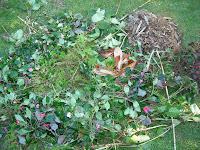An often asked question is "What can or can't I add to my compost heap?" The simple fact is that most things can be composted given enough time. Usually however we are limited by space and the supply of compost isn't large enough to sit around for several years for really woody material to breakdown. If you have large prunings, it is best to use a mulcher or chipper to break into smaller chips or shavings.
The adjacent image shows some of the contents that I recently added to my compost bin. Leaf litter blown onto my drive from a neighbours tree, as well as prunings from impatiens, ferns, hydrangea and pittosporum all made their way into the mound.
Some gardeners will also add supplements into their compost. These can include lime or dolomite lime, particularly if your garden derived from an acidic soil. Many of the red soils of the north from basalt origin have naturally low pH (acidity) and benefit from lime (raise pH). Adding the lime to compost can 'prime' this lift in pH as calcium and bicarbonates within the lime have more time to react and can have a faster 'liming action' when incorporated into your garden. When planting beds, I also recommend adding lime, so we will cover this in more detail at that time.
Another additive sometimes added to compost is a readily available sugar source such as mollases. The sugar in mollases, feed soil microbes which are necessary to breakdown the plant material. Dry stalky grass or woody branches are full of cellulose and plant nutrients, but unfortunately it will take time to release their bounty and this can be hastened using a small amount of a natural sugar like mollases. Many organic growers and commercial vegetable producers also add mollases or humic compounds to their soil at planting to enhance the microbes in their soil. These microbes assist in further breakdown of soil organic matter which helps feed the vegetable crop.
Some things that are best not added to your compost heap are weeds with bulbs, such as oxalis. These daughter bulbs can lay dormant in the soil for many years and the last thing you want to do is to spread a problem from one part of your garden to another.
Other plant material that should be avoided simply due to the length of time they take to compost is flax. Flax can have some great uses around the garden and I will cover some of them in later blogs.
Another plant that should be kept out of your compost heap is agapanthus. The fleshy tuberous roots can easily be propagated by root cutings. The tops can be mulched and added but avoid the roots at all costs or you can find that you have inadvertantly propagated the plant throughout your garden.
The last plant material that I avoid adding to my compost heap are the prunings from rose bushes and bouganvillia. They have thorns that unfortunately rarely breakdown in the composting process and it is a painful experience weeding a vegetable or flower garden with these blackened thorns laying in wait for unsuspecting fingers.
Hmm.. maybe it is worth keeping the wheelie bin - perhaps share it with a neighbour.




Thanks for the advice on not composting agapanthus roots - I've been trying to research it on the web and your blog finally has the answer I was looking for.
ReplyDelete